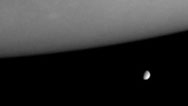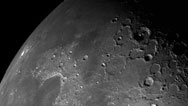The Origin of the Moon
- Teacher Resource
- Posted 12.17.05
- NOVA
Most planetary scientists expected that lunar samples brought to Earth at the end of each of the six Apollo missions would confirm one of three leading hypotheses of the Moon's origin. Instead, samples left all three explanations unconfirmed, requiring the development of a new hypothesis for how the Moon formed. This video segment adapted from NOVA shows Apollo 15 astronauts collecting a type of rock that would help change our understanding of the Moon's — and Earth's — earliest history.
Permitted use:
![]() Download and Share
Download and Share


- Media Type: Video
- Running Time: 3m 57s
- Size: 11.8 MB
- Level: Grades 6-12
-
Log in to Teachers' Domain to download, share, rate, save, and match to state standards.
Source: NOVA: "To the Moon"
This resource was adapted from NOVA: "To the Moon."
Background
As long as people have looked up at the sky and seen the Moon, they have wondered about its structure and origin. Early observations suggested that the Moon was a flat disk that emitted its own light in the night sky and changed shape at regular intervals. Later observations through ground-based telescopes revealed the Moon's spherical shape, as well as its relative size and heavily cratered surface. From these observations, scientists developed hypotheses to explain the Moon's origin. However, it wasn't until Apollo astronauts journeyed to the Moon and returned with lunar samples that scientists were able to formulate the hypothesis of lunar origin that is widely accepted today.
Before the first successful Apollo mission in 1969, scientists entertained three hypotheses for the Moon's origin. One said that the Moon was captured by Earth's gravity as it passed by on its way from some unknown part of the early solar system or galaxy. Another said that the Moon co-formed alongside Earth from the same interstellar cloud of dust and gas responsible for the solar system as a whole. A third said that while Earth was forming, the force of its rotation threw off a huge clump of material that ultimately became the Moon.
Between 1969 and 1972, six manned and three automated missions recovered 382 kilograms (842 pounds) of lunar rocks and sediment. Scientists expected that analysis of these samples would provide hard physical evidence to support one of the existing hypotheses. Instead, the rocks revealed flaws in all three explanations of the Moon's origin and suggested a fourth. The lunar materials showed that the Moon was similar in composition to Earth, but lacked the high iron content characteristic of Earth's rocks. The age of the samples suggested that the Moon formed about 4.48 billion years ago, just after Earth's formation approximately 4.56 billion years ago.
One of the most surprising and important discoveries in the lunar samples was the high concentration of an igneous rock called anorthosite. This type of rock forms from magma at particular pressures and temperatures. The fact that the lunar surface is literally covered with anorthosite suggests that the Moon was once covered by oceans of molten magma. If so, the Moon must have formed at very high temperatures. Together with other evidence, this has led astrophysicists to the most widely accepted hypothesis today: Early in its history, Earth was struck by a Mars-sized asteroid and ejected molten material that ultimately became the Moon.
To learn more about physical characteristics of the Moon, check out Explore the Moon, Extreme Temperatures on the Moon, Galileo on the Moon, and Your Weight on Other Worlds.
Questions for Discussion
- Explain the theory of how and when the Moon formed.
- Why was the anorthosite rock brought back from the Moon by Apollo 15 called the "genesis" rock? Explain in detail.
- The oldest rock on Earth is 3.9 billion years old, and it is a metamorphic rock. Why do we believe Earth is actually at least 4.5 billion years old?
- In what ways does the Moon influence characteristics of Earth?
- What is meant by an Earth-moon system?
Related Resources
-

Going Lunar for Less
In this video extra, see how LCROSS, with ingenuity and spare parts, is exploring a big question on a small budget.
-

Moon Smasher
A NASA satellite called LCROSS heads to the moon in hope of finding buried water.
-

Life on a Tiny Moon?
Saturn's water-spewing moon Enceladus may hold clues to life beyond Earth, says astrophysicist Carolyn Porco.
-

Back to the Moon
Hear David Morrison of NASA's Lunar Science Institute explain why we need to return to the moon.





